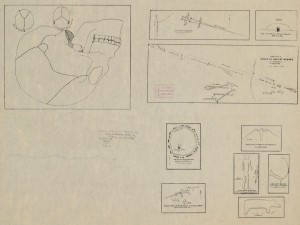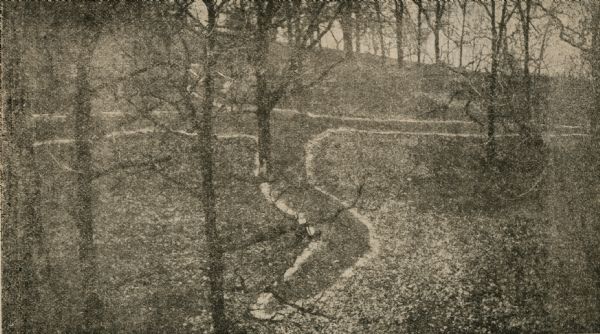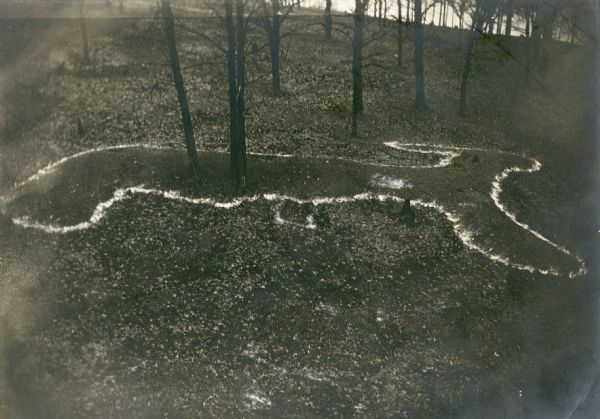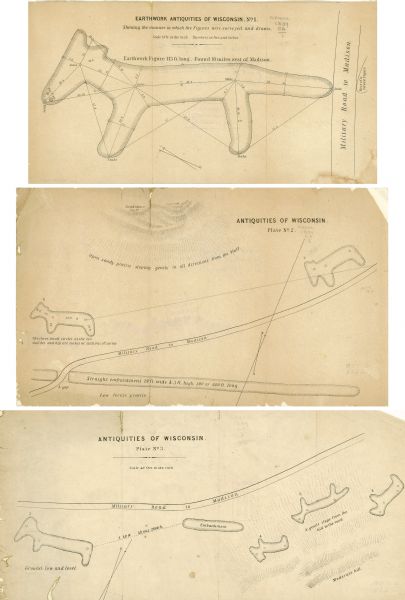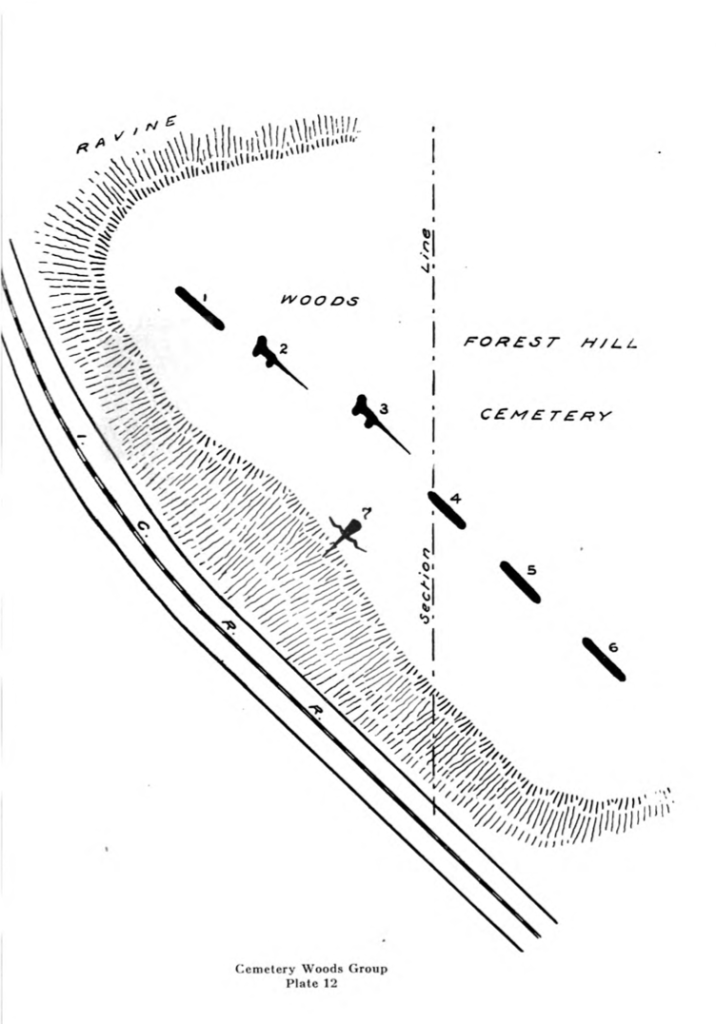The Cosmology of the Mounds
“If the mounds represent change in one sense, they also represent cultural continuity in another. For Native Americans, the mounds are eternally sacred places, the graves of ancestors, that connect them to the land and supernatural. But the mounds have also become highly visible and powerful symbols of the persistence into the modern era of uniquely Native American values and beliefs.” – Robert A. Birmingham (2000).
In order to understand the effigy mounds, we need to understand who built them, and why. Although our understanding has improved significantly since the days of Increase A. Lapham and Charles E. Brown, archaeologists today are still quick to point out that we have only touched the surface in understanding effigy mounds. What we can interpret are the patterns associated with the physical traits, placement, alignment, and orientation of the mounds. We can also use what we do know about the mound builders to carefully piece together the history of the mounds and their meaning.
Indigenous cosmologies tend to be built on a duality of forces that complement, yet oppose each other. These forces are closely linked with the natural world and reflect tensions such as chaos and order, or life and death. In Native American ceremonialism and iconography, this concept is often depicted through symbols of the Upper World of air and sky and the Lower World composed of a watery underworld. The earth lies between these two realms. Scholars today believe that effigy mounds may tell the story of the power and forces of the natural world, through the physical recreation of the cosmos. Strong evidence also suggests that the effigy mounds are depictions of kinship-based social divisions. In effect, effigy mounds act as a “map of ancient belief systems.”
Although some effigy mounds serve as burial sites, many were also used for ceremonial purposes. R. Clark Mallam, one of the leading twentieth-century effigy mound scholars, suggested that effigy mounds were built to restore balance and harmony to the earth in ways akin to the life and death cycles represented in Native belief systems. The mounds served as representations of the cosmological order. Each construction of this order renewed the world.
Finally, effigy mound sites likely served as boundary markers in addition to ceremonial centers. Many scholars have pointed out that effigy mounds might reflect clan structures, some of which can still be seen today. For example, some mounds are in the shape of animals that still serve as Ho-Chunk clan animals, such as the thunderbird, bear, wolf, and water spirit. Sites in which multiple forms of effigy mounds are found may have served as important ritual and meeting centers constructed on the territorial boundaries of Late Woodlands tribes.
Reading Madison’s Mounds

Map Showing the Distribution of Mound Groups in Wisconsin, 1916. Wisconsin Historical Society Image 92138.
The Four Lakes region of Wisconsin, which includes lands surrounding the successive lakes of the Yahara River (Mendota, Monona, Waubesa, Kegonsa, and Wingra), has one of the highest densities of effigy mounds in the Midwest. Of the 15,000 mounds located in Wisconsin, 1,200 qualify as effigies. The Four Lakes region is one of the mostly highly documented and studied areas for mounds, as the City of Madison, located between Lake Mendota and Lake Monona, holds the state government, the University of Wisconsin, and the Wisconsin Historical Society. Each of these institutions has contributed greatly to knowledge of Late Woodlands culture and effigy mounds.
In addition to having an unusually high density of effigy mounds, the Four Lakes region also represents a unique crossroads for different types of mounds. Mound groupings here often include a mix of spirits from the earth, water, and air, rather than just one dominant realm, in contrast to (for example) the Lower Wisconsin River region, which is home to many water-spirits. Some effigy mounds you will see near Madison are only found in the Four Lakes region.
In this section you will find descriptions of the effigy mound shapes, followed by an explanation of how the mounds were situated within the natural environment. We have given special attention to both the mound forms unique to the Four Lakes area and to Forest Hill cemetery in order to prepare you for the mounds you can encounter right outside your door.
Upper World Mounds
Shapes
Effigy mounds at Four Lakes included many Upper World forms. Most prominent are the straight-winged hawk effigies, and bent-winged effigies that many have represented either eagles or mythical Thunderbirds. Thunderbirds were particularly powerful beings within the Late Woodlands cosmology, and were said to posses nearly any power imaginable. One particularly astonishing eagle/Thunderbird mound has a wingspan of 624 feet. Four Lakes was also once home to nearly a dozen goose effigy mounds, more than any other region. In fact, the bent-winged variation of the goose mound can only be found flying to or from the Four Lakes. Upper World forms comprise roughly 34% of the all effigies, making them the most numerous.
Conical mounds also fall into category of Upper World. They are usually found within close proximity to bird and other Upper World mounds. Because of this, researchers believe these mounds may represent celestial bodies such as the sun or the moon. Many of the conical mounds predate the effigies found nearby. This form of construction existed long before effigy construction, but new conical mounds were built during the Late Woodlands period as well. The conical mounds found at Governor Nelson State Park are amongst the oldest in the Four Lakes region.
Location and Alignment
Mounds consistently align with the landscape by following the contours of land formations, topography, and waterways. They were often were placed in areas of ecological significance, such as high elevation bluffs overlooking lakes, rivers, and wetlands, perhaps acknowledging significant food resources found in waterways including fish, waterfowl, and edible plants.
Upper World mounds are prominent in western Wisconsin’s hilly bluffs. Within the Four Lakes regions, Lake Monona is home to the most bird mounds. Mendota, along with the nearby, small Lake Wingra, boasts the largest number of effigy mound groupings. Many of the mounds at found at these two lakes fall into the Upper World category, with goose mounds, bird mounds, and conical mounds all represented.
The Late Woodland people often constructed Upper World mounds on high ridges. While some of these mounds align with celestial events, many Upper World forms are pointed either towards or away from bodies of water. This is particularly true of the goose mounds in the Four Lakes region, which fly to and from the lakes. In this sense, these mounds serve as depictions of the migration patterns of real geese.
Lower World Mounds
Shapes
Lower World effigy mounds are depictions of the the creatures that inhabit the watery underworld of the Late Woodlands cosmology. One of the most common forms is that of the water panther, sometimes referred to as water-spirit. These long-tailed panthers inhabited Wisconsin’s waterways. While the water panthers are usually thought of as ominous figures, they also are the sources of medicine and power.
Other Lower World forms include snakes, turtles, and lizards. The site at Observatory Hill on the University of Wisconsin Madison campus was believed to be home to a double-tailed turtle effigy mound. Today, researchers claim the mound is not a turtle, but a water-spirit shown from an aerial prospective rather than in profile. Some argue it depicts not one water panther, but twin panthers placed back-to-back. In any case, the mound on Observatory Hill is rather unique!
Many scholars of the mounds group linear mounds within the Lower World category, though this classification is still a matter of debate. Linear mounds may represent bodies of water such a rivers and lakes. If this is true, then they complement conical mounds symbolizing celestial bodies. Linear mounds might also serve as more abstract boundaries dividing the Upper and Lower Worlds. Finally, some mound scholars believe linear mounds are the long tails of unseen water spirits. Linear mounds are frequently found near Lower World forms, suggesting a strong connection.
Location and Alignment
Lower World mounds are prominent within eastern Wisconsin’s low-lying wetlands. They are also found close to lakes, riverways, and springs. The Four Lakes region was once home to over a dozen water panther mounds, some of which are well preserved today. Many of these water panthers could be found near Waubesa and Kegonsa, which lie on southern wetlands. Unlike bird mounds, which fly to and from bodies of water, most Lower World mounds point towards the nearest body of water.
Earth Mounds
Shapes
Effigies in the shape of terrestrial animals form the final main category of mounds found in the Four Lakes region. Explorers have found mounds in the shape of wolves, foxes, buffalo, deer, and even human forms. The Four Lakes region is home to many mammalian mounds, some of which are quite rare. Deer, various canines, and many bears march across the slopes and ridges of Four Lakes. If the theory that effigy mounds were built to reflect tribal affiliations is true, as many as ten tribes may have used the Four Lakes region as meeting, ceremonial, and burial grounds. Because of the regions astonishing variety of Upper, Lower, and terrestrial mounds, researchers have pointed out that the Madison area is not only the capital of Wisconsin, but of effigy mound culture as well!
Rare forms in the Four Lakes region once included two deer depicted with all four legs, a rabbit effigy mound, and a canine with two conical mounds constructed at its feet.
Location and Alignment
Scholars associate effigy mounds in this category more closely with possible tribe territories than with geographic locations. While bear mounds are prominent in southwestern Wisconsin, the construction of other forms of animal mounds does not seemed to be strongly linked to a particular geographic region.
The alignment of animal mounds is particularly interesting. While these mounds tend to march across ridges, rather than to or from water sources, they are often shown from different perspectives. While profiles are the most common, the Four Lakes region was home to at least three aerial-perspective bear mounds.
The Mounds at Forest Hill
Forest Hill Cemetery once contained seven mounds, as shown in the figure above: Three linear mounds, two water spirits, and one linear mound in a northeast to southwest line; to the southeast of this line, a single goose mound. The head of the goose was destroyed in 1886 by grading for the Illinois Central Railway, and three of the linear mounds were destroyed to make room for new grave sites during the expansion after 1905. This mound grouping was likely built between A.D. 500 and A.D. 1000.
Forest Hill: The Goose Mound
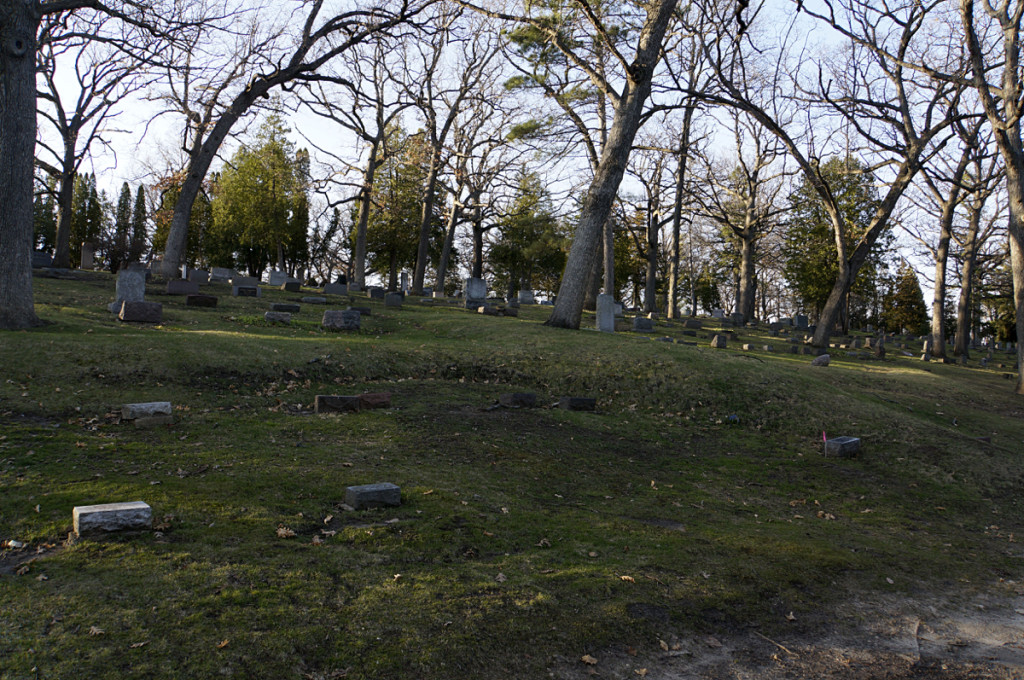
The goose mound at Forest Hill Cemetery. The head was destroyed by grading for the Illinois Central Railway in 1886. Photo by William Cronon.
The land surrounding Lake Wingra had at least two (possibly four) goose mounds, one of which is still visible at Forest Hill Cemetery. The other confirmed goose mound was located near a spring in what is now the University of Wisconsin Arboretum, and was destroyed along with other mounds for land conversion in the early-twentieth century. Goose mounds were often oriented towards water, such as this one seen flying with its wings extended down a hill towards Lake Wingra. These mounds likely represent the significance of water as a resource, in addition to the water symbolism presented by the other Forest Hill mound shapes.
The goose mound can be found in Forest Hill Cemetery section 15.
Forest Hill: The Water Spirit Mounds
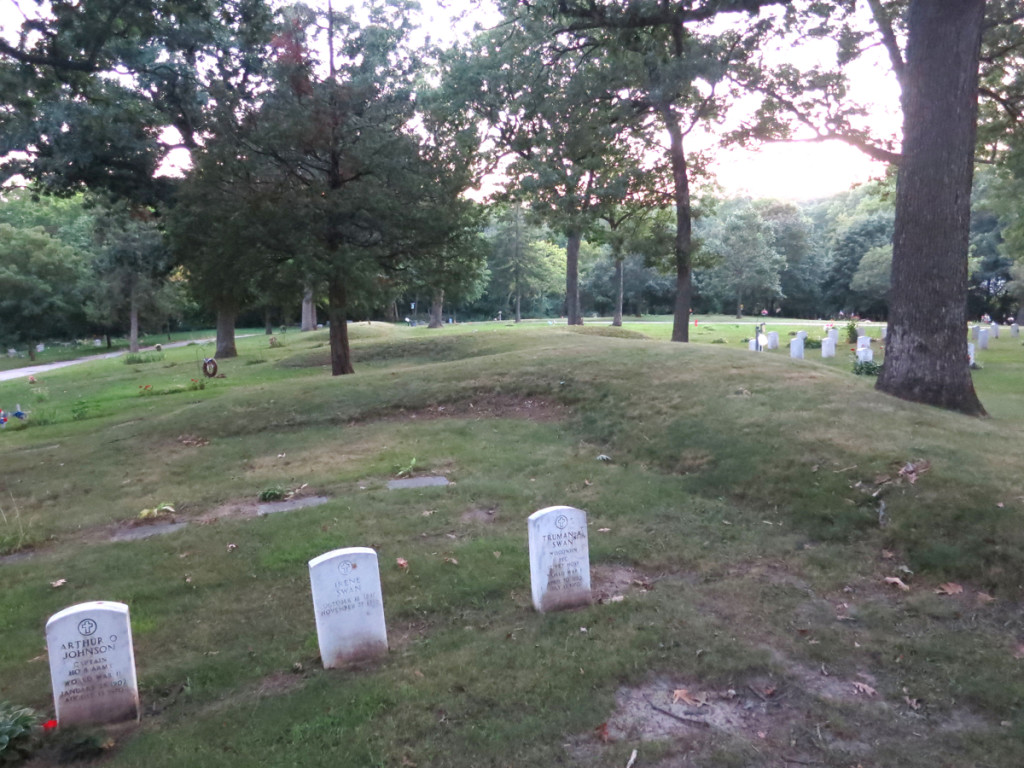
A water spirit mound at Forest Hill Cemetery, surrounded by military graves. Photo by William Cronon.
Long-tailed water spirit or “panther” mounds are common in the Four Lakes area, with two of 16 in the Forest Hill Cemetery grouping. This mound shape is often found near lakes and and wetlands, representing rebirth and renewal, or near spring-fed areas, which are considered sacred and in some Native cultures represent a direct link to the underworld. Forest Hill’s water spirits were built in profile view, with two legs visible. They also feature long, linear tails.
The water spirits can be found in Forest Hill Cemetery section 35.
Forest Hill:The Linear Mound
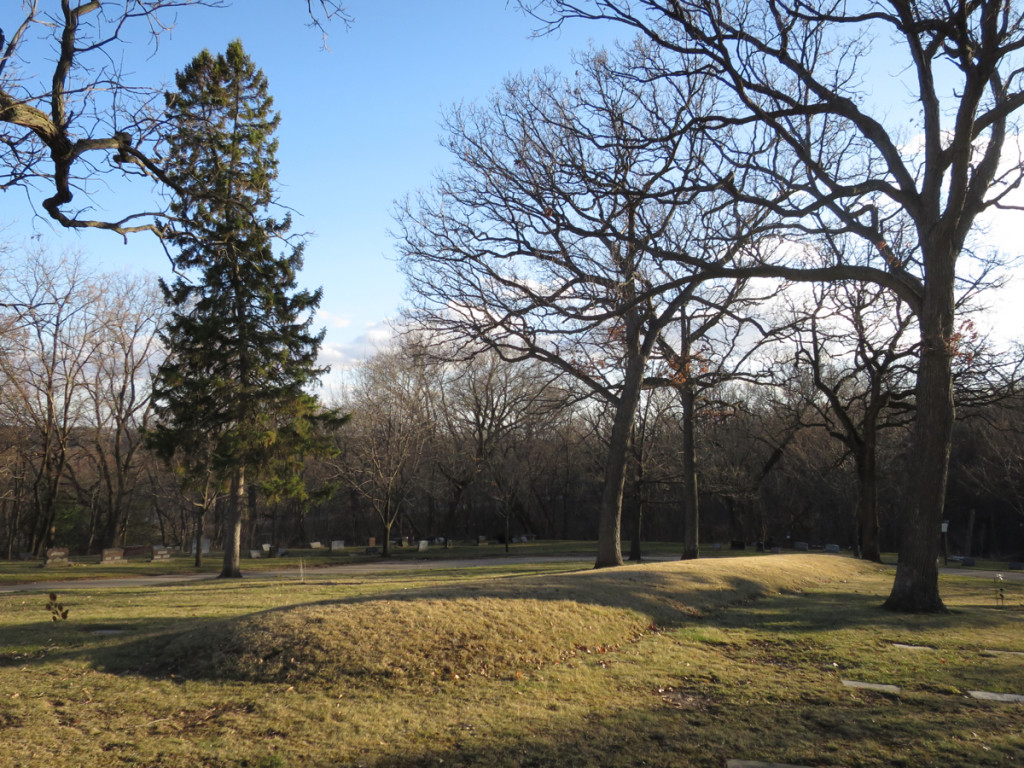
A linear mound at Forest Hill Cemetery. A 1915 drawing by Charles E. Brown showed a total of four linear mounds, but several were destroyed to make room for new gravesites. Today, mounds in Wisconsin are protected from disturbance by the Burial Sites Preservation Law. Photo by William Cronon.
Linear mounds are shaped as long, low embankments, and tend to be grouped amidst other Upper and Lower world shapes. Though found across the effigy landscape, these shapes may also represent the divide in cosmology in Native belief systems. Some scholars have argued that the linear mounds represent the tail of a water spirit, while others believe they represent a snake. The linear mound at Forest Hill is located near the two water spirit mounds, on a ridge that over looks Lake Wingra.
The linear mound can be found in Forest Hill Cemetery section 35.
VISITING A MOUND
“When we visit an effigy mound site and then share that experience with others who then share their experience and so on and so on, we begin to dramatically alter cultural landscapes of countless individuals and build a new recognition of the importance of those who have gone before and who have left their legacy on the landscape. “ – Mark Cupp, executive director of Cultural Landscape Legacies (2015).
Many people, particularly members of Native American tribes, consider mound sites to be a sacred space. When visiting a mound, you can use the information from these pages and your imagination to discover the story of who built the mounds and why, and you can reflect on the meaning of the mounds, and what the mounds mean in your own cultural landscape. Please be respectful of this sacred space.
To guide you through a visit to a mound site, we suggest you consider some of the following questions:
- Physical – What is the shape and size of the individual mound? What grasses, vegetation, and other natural features are on top of the mound?
- Location – What is the order of the shapes in the group? Do they counterbalance each other? What may be the relationship between the shapes in the mound group? What are the natural surroundings of the area? How do the mounds connect with the landscape? Are the mounds aligned with any natural features?
- Spiritual – What spirits might the shapes represent? What stories can they tell? What do you bring to the mound site, and what will you take away from this experience?
Back to Top | Effigy Mounds Main Page | History of the Mounds | Visiting the Mounds

